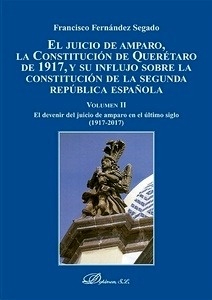La justicia constitucional. Su devenir a lo largo de un siglo y medio (1787-1938) Tomo I. "Los inicios de la justicia constitucional en los Estados Unidos (1787-1864). (2 vols.)"
Fernández Segado, FranciscoEditorial Dykinson, S.L.


Formato papel
[Disponible. 3-7 días]
antes:
150,00 €
ahora:
142,50 €
La justicia constitucional. Su devenir a lo largo de un siglo y medio (1787-1938) Tomo I. "Los inicios de la justicia constitucional en los Estados Unidos (1787-1864). (2 vols.)"
Fernández Segado, Francisco
Editorial Dykinson, S.L.
The work La Justicia Constitucional. Su devenir a lo largo de un siglo y medio (1787-1938) , through four extensive volumes, aims to carefully study the evolution of constitutional justice in the century and a half that has elapsed since the North American Constitution of 1787 until 1938, the Austrian Constitutional Court's last year of operation, given that, in 1938, following the invasion of Austria by Nazi troops, the Austrian Federal Republic ceased to exist, and with it, obviously, the Constitutional Court, an institution whose paternity must be attributed to Kelsen.
The first volume of this work focuses on North America, with a time frame between 1787 and 1864, the year of the death of the Chief Justice of the Supreme Court Roger Brooke Taney, whose Court, like the one that preceded him under the Chief Justiceship of John Marshall, declared a federal law unconstitutional. Although the transcendental question of whether the Federal Convention of Philadelphia recognized judicial review, that is, the judicial power to control the constitutionality of laws, it has been, and still is today, highly controversial by American doctrine. For our part, we are inclined to think, in line, among many other authors, with the great Harvard Professor James B. Thayer, that in the aforementioned Constitutional Convention it was admitted that the courts had the power to disapply a law to the case before them because of its unconstitutionality.
In this first volume, of course, we devote a preliminary chapter to the various historical precedents of judicial review of the constitutionality of laws, paying particular attention to the figure of that great English judge who was Lord Edward Coke and the famous Bonham's case (1610), which would have such a great impact on the English colonies in America, also taking into account the review of colonial legislation carried out by the Privy Council and its occasional application of the ultra vires principle. The figure of James Otis and his intervention in the transcendental Writs of assistance case (1761) also deserves very particular attention.
In the following chapter, after analysing the first cases of exercise of judicial review by state courts, we pay close attention to the Constitutional Convention in Philadelphia and its position before judicial review, after which we go on to analyse in some detail the discussion that arose in some state Conventions for ratification of the Federal Constitution, very particularly in the New York Convention, which led to criticism of the Constitution of the anti-federalist Brutus and the replies of Alexander Hamilton in The Federalist Papers. This chapter closes with the analysis of the Judiciary Act of 1789.
The third chapter examines in some detail the future of the judicial review in what is usually identified as the pre-Marshall Court (1789-1801), taking a look at some of the most relevant cases from the litigation arising from the Invalid Pension Acts (1792 and 1794) to Cooper v. Telfair (1800), without forgetting the exercise of judicial review by some state courts. The study of the Federalist Alien and Sedition Acts (1798) and the disproportionate Republican reaction to those laws, reflected in the Virginia and Kentucky Resolutions, closes this chapter.
The two subsequent chapters focus their attention on the Marshall Court (1801-1835), successively analysing the background of the Marbury opinion (chapter four), which we believe is essential for a better understanding of the Marbury v. Madison case, the judgment itself, to which we dedicate extensive attention, with the study, among other aspects, of the two argumentative blocks, the different critical considerations raised by John Marshall's argument, and of the various arguments, both of a general nature and taken from the literal text of the Constitution, on which the Chief Justice was going to base the doctrine of judicial review.
In the second volume, the work analyses the contract clause, the outstanding Fletcher v. Peck opinion (1810) and the control of the constitutionality of state legislation by the Marshall Court, which gives rise to studying the progressively broader interpretation of the aforementioned constitutional clause in subsequent years, which would lead to such transcendental cases as that of Dartmouth College (1819) or that of Ogden v. Saunders (1827), all of them are the subject of a detailed study.
Chapter seven and the last of this second volume focuses on the judicial review in the Taney Court, in which, originally, the emphasis is placed on the Dred Scott v. Sandford opinion (1857), which is the object of very careful attention. As this judgment is difficult to understand if it is not framed in the historical development of slavery in North America and the legal status of people of colour, the chapter pays particular attention to them, studying from the Fugitive Acts and the reaction of some States through the Personal Liberty Laws, to the Kansas-Nebraska Act of 1854, without forgetting the Missouri controversy, the Mexican War and the David Wilmot Proviso (1846), as well as the later Missouri Compromise (1850). The political interference over the judgment by President James Buchanan, Taney's supposed opinion of the court, the different concurring opinions and, in a very particular way, the two dissenting opinions of Justices McLean and Curtis, are the subject of a very special attention, as well as the reactions triggered by the judgment and the situation of the Supreme Court before the Civil War.
In the third and fourth volumes of the work, the aim is to study the future of constitutional justice in Europe, with particular attention to the situation in France; the European impact of liberal democratic constitutionalism, which finds its paradigm in the Constitution of the Church of Saint Paul of Frankfurt (Frankfurter Paulskirchenverfassung) of 1849, which contemplated a constitutional jurisdiction with broad powers; constitutional justice in the two Swiss Constitutions, and the Constitution of the Austro-Hungarian Empire of 1867, which would lead to the institutionalization of the Reich Court (Reichsgericht), considered by Battaglini as the first attempt to institutionalize a Constitutional Court. We will also pay particular attention to Jellinek and his important booklet Ein Verfassungsgerichtshof für Österrich (1885). What has been called the Weimar laboratory will also be the object of careful study and, as could not be otherwise, Kelsen and his extraordinary scientific work, which, in the present case, would find its culmination in the Austrian Constitutional Court. Obviously, we will not leave aside the exciting controversy between Carl Schmitt and Hans Kelsen.
Along with the previous one, we will examine some transcendental aspects of the evolution of the United States Supreme Court, from the entry into force of the Reconstruction Amendments to the New Deal cases and President Roosevelt's Court-packing plan of February 1937. And, finally, we will not stop paying attention to constitutional justice in Latin America, whose interest seems to us beyond any doubt.
The first volume of this work focuses on North America, with a time frame between 1787 and 1864, the year of the death of the Chief Justice of the Supreme Court Roger Brooke Taney, whose Court, like the one that preceded him under the Chief Justiceship of John Marshall, declared a federal law unconstitutional. Although the transcendental question of whether the Federal Convention of Philadelphia recognized judicial review, that is, the judicial power to control the constitutionality of laws, it has been, and still is today, highly controversial by American doctrine. For our part, we are inclined to think, in line, among many other authors, with the great Harvard Professor James B. Thayer, that in the aforementioned Constitutional Convention it was admitted that the courts had the power to disapply a law to the case before them because of its unconstitutionality.
In this first volume, of course, we devote a preliminary chapter to the various historical precedents of judicial review of the constitutionality of laws, paying particular attention to the figure of that great English judge who was Lord Edward Coke and the famous Bonham's case (1610), which would have such a great impact on the English colonies in America, also taking into account the review of colonial legislation carried out by the Privy Council and its occasional application of the ultra vires principle. The figure of James Otis and his intervention in the transcendental Writs of assistance case (1761) also deserves very particular attention.
In the following chapter, after analysing the first cases of exercise of judicial review by state courts, we pay close attention to the Constitutional Convention in Philadelphia and its position before judicial review, after which we go on to analyse in some detail the discussion that arose in some state Conventions for ratification of the Federal Constitution, very particularly in the New York Convention, which led to criticism of the Constitution of the anti-federalist Brutus and the replies of Alexander Hamilton in The Federalist Papers. This chapter closes with the analysis of the Judiciary Act of 1789.
The third chapter examines in some detail the future of the judicial review in what is usually identified as the pre-Marshall Court (1789-1801), taking a look at some of the most relevant cases from the litigation arising from the Invalid Pension Acts (1792 and 1794) to Cooper v. Telfair (1800), without forgetting the exercise of judicial review by some state courts. The study of the Federalist Alien and Sedition Acts (1798) and the disproportionate Republican reaction to those laws, reflected in the Virginia and Kentucky Resolutions, closes this chapter.
The two subsequent chapters focus their attention on the Marshall Court (1801-1835), successively analysing the background of the Marbury opinion (chapter four), which we believe is essential for a better understanding of the Marbury v. Madison case, the judgment itself, to which we dedicate extensive attention, with the study, among other aspects, of the two argumentative blocks, the different critical considerations raised by John Marshall's argument, and of the various arguments, both of a general nature and taken from the literal text of the Constitution, on which the Chief Justice was going to base the doctrine of judicial review.
In the second volume, the work analyses the contract clause, the outstanding Fletcher v. Peck opinion (1810) and the control of the constitutionality of state legislation by the Marshall Court, which gives rise to studying the progressively broader interpretation of the aforementioned constitutional clause in subsequent years, which would lead to such transcendental cases as that of Dartmouth College (1819) or that of Ogden v. Saunders (1827), all of them are the subject of a detailed study.
Chapter seven and the last of this second volume focuses on the judicial review in the Taney Court, in which, originally, the emphasis is placed on the Dred Scott v. Sandford opinion (1857), which is the object of very careful attention. As this judgment is difficult to understand if it is not framed in the historical development of slavery in North America and the legal status of people of colour, the chapter pays particular attention to them, studying from the Fugitive Acts and the reaction of some States through the Personal Liberty Laws, to the Kansas-Nebraska Act of 1854, without forgetting the Missouri controversy, the Mexican War and the David Wilmot Proviso (1846), as well as the later Missouri Compromise (1850). The political interference over the judgment by President James Buchanan, Taney's supposed opinion of the court, the different concurring opinions and, in a very particular way, the two dissenting opinions of Justices McLean and Curtis, are the subject of a very special attention, as well as the reactions triggered by the judgment and the situation of the Supreme Court before the Civil War.
In the third and fourth volumes of the work, the aim is to study the future of constitutional justice in Europe, with particular attention to the situation in France; the European impact of liberal democratic constitutionalism, which finds its paradigm in the Constitution of the Church of Saint Paul of Frankfurt (Frankfurter Paulskirchenverfassung) of 1849, which contemplated a constitutional jurisdiction with broad powers; constitutional justice in the two Swiss Constitutions, and the Constitution of the Austro-Hungarian Empire of 1867, which would lead to the institutionalization of the Reich Court (Reichsgericht), considered by Battaglini as the first attempt to institutionalize a Constitutional Court. We will also pay particular attention to Jellinek and his important booklet Ein Verfassungsgerichtshof für Österrich (1885). What has been called the Weimar laboratory will also be the object of careful study and, as could not be otherwise, Kelsen and his extraordinary scientific work, which, in the present case, would find its culmination in the Austrian Constitutional Court. Obviously, we will not leave aside the exciting controversy between Carl Schmitt and Hans Kelsen.
Along with the previous one, we will examine some transcendental aspects of the evolution of the United States Supreme Court, from the entry into force of the Reconstruction Amendments to the New Deal cases and President Roosevelt's Court-packing plan of February 1937. And, finally, we will not stop paying attention to constitutional justice in Latin America, whose interest seems to us beyond any doubt.
Formato papel
[Disponible. 3-7 días]
antes:
150,00 €
ahora:
142,50 €
FICHA TÉCNICA
- ISBN: 978-84-1070-887-7
- Fecha de edición: 2025
- Nº edición: 1
- Idioma: Castellano
- Encuadernación: Rústica
- Nº páginas: 1784
- Materias: OTRAS MATERIAS JURÍDICAS / Historia del Derecho y de las Instituciones /







